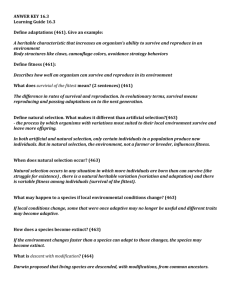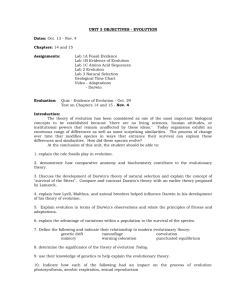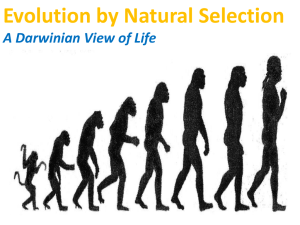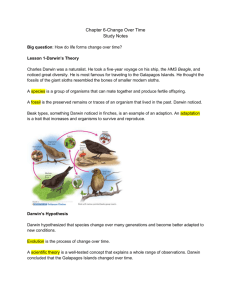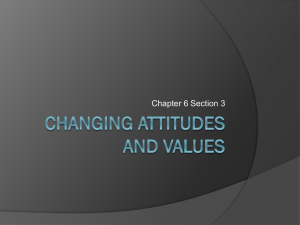File - Makayla Nielsen`s ePortfolio
advertisement
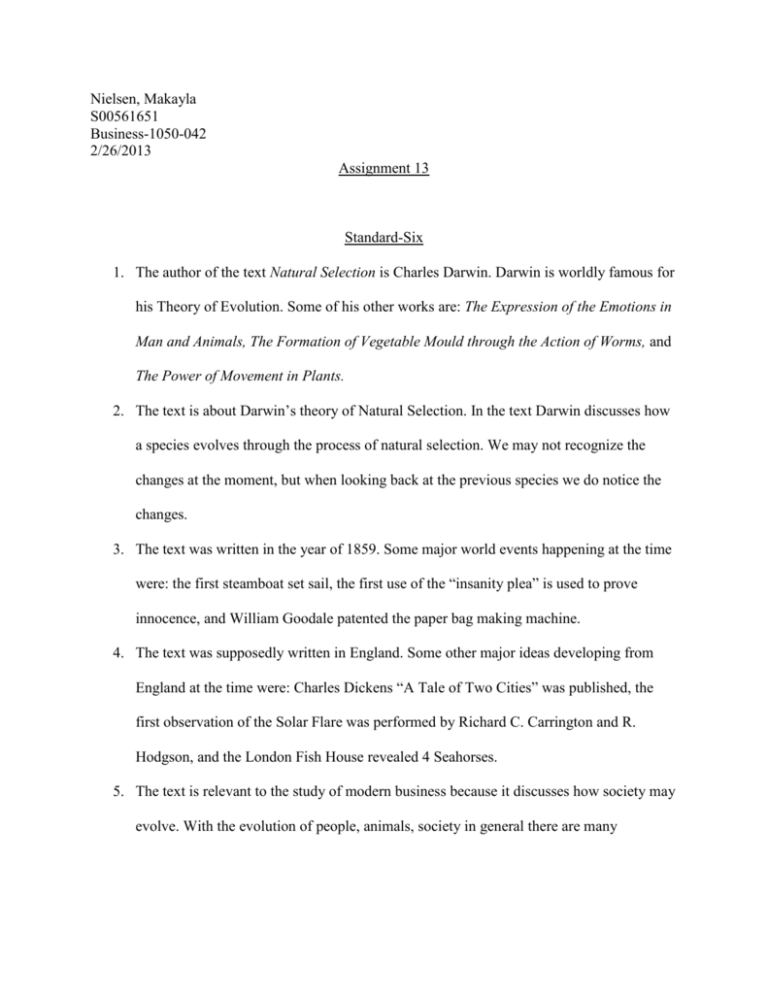
Nielsen, Makayla S00561651 Business-1050-042 2/26/2013 Assignment 13 Standard-Six 1. The author of the text Natural Selection is Charles Darwin. Darwin is worldly famous for his Theory of Evolution. Some of his other works are: The Expression of the Emotions in Man and Animals, The Formation of Vegetable Mould through the Action of Worms, and The Power of Movement in Plants. 2. The text is about Darwin’s theory of Natural Selection. In the text Darwin discusses how a species evolves through the process of natural selection. We may not recognize the changes at the moment, but when looking back at the previous species we do notice the changes. 3. The text was written in the year of 1859. Some major world events happening at the time were: the first steamboat set sail, the first use of the “insanity plea” is used to prove innocence, and William Goodale patented the paper bag making machine. 4. The text was supposedly written in England. Some other major ideas developing from England at the time were: Charles Dickens “A Tale of Two Cities” was published, the first observation of the Solar Flare was performed by Richard C. Carrington and R. Hodgson, and the London Fish House revealed 4 Seahorses. 5. The text is relevant to the study of modern business because it discusses how society may evolve. With the evolution of people, animals, society in general there are many opportunities for new businesses to develop. As for older businesses they evolve themselves to fit the needs of the ever changing world. 6. The text made me feel a complete understanding of Natural Selection and how it still thrives in modern society. I feel that Darwin’s literature has always been highly stressed throughout my education and so there is a complete understanding as to how Natural Selection applies to Business as well as to Critical Thinking. Darwin was a Critical Thinker himself in that he proposed a question and set out to find an answer. Once the answer was found, he proposed solutions on how to avoid futuristic problems. Questions 1-12 1. What is the name of Darwin’s theory, and why give it that name? a. The name of Darwin’s theory is The Theory of Natural Selection. It is given that name because Darwin took note of the physical changes in finches upon the Galapagos islands. He proclaimed that within each new generation there were slight differences in adaptability to survive. He noticed the differences in environment affected the differences in the birds beak shape, their calls, and yet they all originated from the same species but were so diverse. Thus the theory of evolution developed on his thinking of natural selection. 2. How does it explain the survival of some species and the extinction of others? a. It explains the survival and extinction of some species through the use of natural selection and survival of the fittest. Natural selection can be defined as the success in procreation or reproduction of a specific species. As each generation is produced, there are slight changes enabling them to survive the constantly changing environment. This is where survival of the fittest comes in play. Survival of the fittest basically states that if a species cannot adapt to the environment in which it lives in, then it will die off and become extinct, however, through evolution the species may thrive and survive. 3. How does diversity determine who survives? a. Diversity determines who survives by whichever species is more adaptable. As in the case of Darwin’s finches, the birds that adapted to food quality due to overpopulation and environmental changes were able to survive more easily than those who continued to eat the same food that was becoming more and more scarce. 4. Since animals do not change or evolve in their own lifetime in response to changes in the environment, how do species change over time? a. Species change over time with the production of a new adaptation within the new generation. For example, looking at the human lifestyle today versus 50 years ago we see a great difference in how we eat, work, and live. If we were living in the time of 50 years ago we wouldn’t see a difference in how we were living within our lifetime, but over a span of years the human race has changed greatly within the production of each generation. 5. In the Glossary read the entry called Survival of the Fittest, and Social Darwinism. Then explain how Darwin’s theory is different from those other two theories. a. Darwin’s theory is different from the other two theories on the basis that it is completely natural and that man has no effect on the changes. Rather Nature herself tends to the being of which she selects whereas man (from Social Darwinism) selects to tend to solely himself. As for the difference in survival of the fittest, Natural Selection provides a more suitable explanation as to why some species survive while others end up extinct. In order to survive they must produce generations that adapt to their changing environment. 6. How does Darwin’s theory relate to Employment (or job seeking), Industry, Economics, and Business? a. Darwin’s theory relates to employment, industry, economics, and business in that it discusses how the world is continually changing. With the change of society, businesses either are created or evolve to fit the standards of the modern world, or they themselves become extinct. Through this industries boom creating more opportunity for employment and boosting the economic side, yet at times when we do not carefully make the correct selections, the economy falls and employment is cut in order to survive. 7. In the Glossary read the entries called: Toynbee-ism and Extinction. Explain how the economy, or businesses experience episodic mass extinctions just as the ecosystem does. a. The economy experiences mass extinctions like the ecosystem in the sense that the world is constantly changing. With change comes new demands for modern products. If a business fails to keep up with the products, it becomes extinct in the sense that no one provides profit to the business and so it goes belly up. An example of this would be music stores. Now that in today’s society you can download all the music you want and store it on an iPod or an mp3 player, music stores are failing. No one buys tapes, rarely are CD’s purchased and records sell for less than 20 cents. With hardly anyone making these purchases, music stores have no means of existing. 8. What is the difference between a static and dynamic economy? a. A static economy is an economy that is not moving or changing. A Dynamic economy is one that contains a lot of energy and is constantly in motion. 9. How would someone plan a career in a static economy? a. In a static economy someone may plan a career in the sense of no development. A good example of this would be a restaurant. A career in the restaurant has no change. Other than moving up in positions, the restaurant work is still there. 10. How does the career plan change in a dynamic economy? a. In a dynamic economy, a career plan would consist of constant change to adapt to society. An example would be an acting career. With acting and society one must meet the needs of the audience. The audience is constantly changing what they want to see so the actor/actress must change their skills and movie themes in order to succeed. 11. Which makes a stronger business: uniform thinking or diverse thinking? Why? a. Diverse thinking makes for a stronger business. Because it adapts to changing ideas of society and it is more creative in developing new products. 12. Which is better in business: dynamic response or rigid-unresponsiveness? Why? a. A dynamic response is better in business. Because with the high energy and constant motion will help the business to evolve and adapt to modern society. 10 Vocabulary 1. Accumulate a. To collect or obtain a large amount of something over a period of time. 2. Ensues a. To follow closely after something. 3. Volition a. The ability to make conscious choices or decisions. 4. Affinities a. A similarity or connection between people or things. 5. Brevity a. Shortness in time. 6. Quadruped a. An animal with four limbs and feet, all of which are used for walking. 7. Scrutinizing a. To examine somebody or something closely and carefully. 8. Manifestly a. Clear to see or understand. 9. Injurious a. Causing harm, hurt, damage, or distress. 10. Potent a. Possessing great physical, political or military strength and power. Works Cited "Charles Darwin Biography." Bio.com. A&E Networks Television, n.d. Web. 27 Feb. 2013 "Historical Events for Year 1859." Today in History, Birthdays & History Articles. N.p., n.d. Web. 27 Feb. 2013 "Timeline Great Britain 1800-1859." Timeline Great Britain 1800-1859. N.p., n.d. Web. 27 Feb. 2013 "Online Dictionary." Online Dictionary. N.p., n.d. Web. 27 Feb. 2013 Darwin, Charles. "Natural Selection." Critical Thinking, Readings from the Literature of Business and Society. By Edward G. Engh. N.p.: n.p., n.d. 135-39. Print
